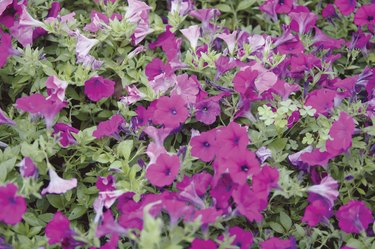Things You'll Need
Hose with spray nozzle
Sharp, clean scissors
Bag
Neem oil
Spray bottle or garden sprayer

Petunias (Petunia x hybrida) make showy additions to flowerbeds, hanging baskets and pots or containers. These plants technically grow as frost-tender perennials in U.S. Department of Agriculture plant hardiness zones 10 through 11, although most people treat them as annuals. Petunia pests include spider mites, tiny, eight-legged spider relatives that look like tiny, moving dots to the naked eye. Mite feeding damage first appears as a light stippling on leaves, then leaves develop a bronze color, turn yellow or red and drop off the plant. You may also see fine webbing on the leaves.
Step 1
Water the petunias deeply whenever the soil 1/2 inch below the surface feels dry to the touch if the petunias are growing in a container or whenever soil about 1 inch below the surface feels dry if the petunias are growing in the ground. Mites are most problematic on drought-stressed plants.
Video of the Day
Step 2
Pinch or cut off portions of the petunia that are severely infested with mites if the infestation is largely concentrated in these areas. Bag and dispose of the infested portions you remove. This pruning is particularly beneficial where mites have spun webs.
Step 3
Spray the petunias down with a forceful spray of water every few days to knock these pests off and alleviate the dusty conditions mites prefer. Make sure the spray reaches leaf undersides, as mites tend to cluster on lower leaf surfaces.
Step 4
Mix 5 tablespoons of neem oil with 1 gallon of water. You can also use another horticultural oil. While most oils use this dilution rate, check the label for specifics. You can also use another type of horticultural oil, if you prefer.
Step 5
Put the mixture in a spray bottle or garden sprayer and spray the petunia with the mixture. Make sure you cover the plant's leaves thoroughly, though not to the point of runoff, and reach leaf undersides. The oil will only kill mites it directly contacts, so you may need to do this each week until the mites are under control.
Warning
If possible, spray the petunias early in the day so the moisture on the leaves evaporates quickly, minimizing the potential for fungal disease problems. Test the oil spray on a small, inconspicuous section of the petunia and check that spot for injury for 48 hours before treating the entire petunia. Do not apply horticultural oils to drought-stressed plants or on windy days or when temperatures are above 90 degrees Fahrenheit. Also do not apply horticultural oil within 30 days of a sulfur application to avoid injuring petunias and other plants.
Video of the Day